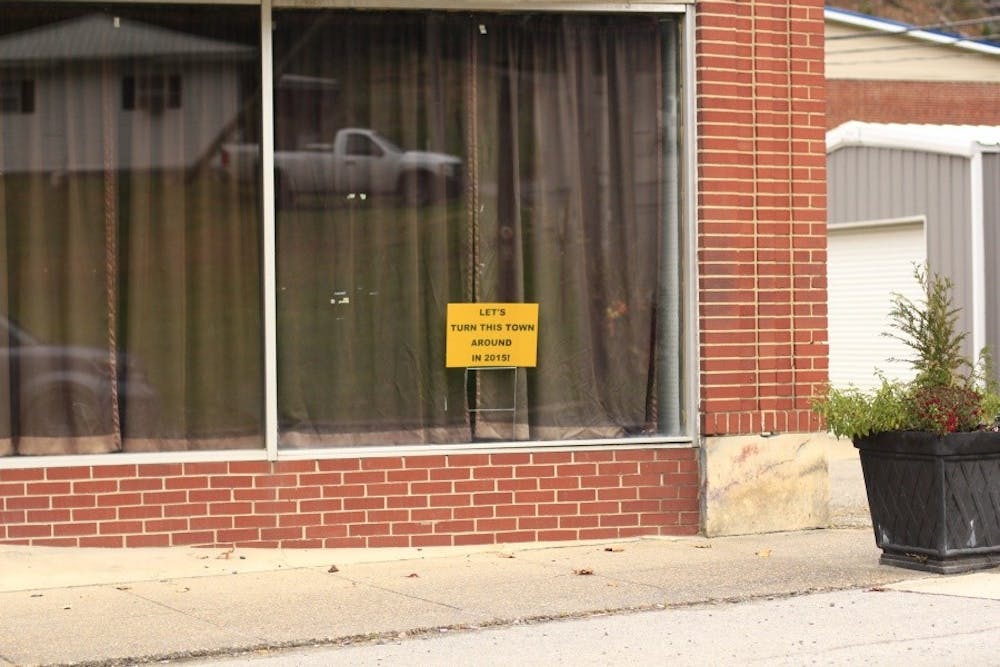Miami University currently owns 7,000 tons of coal - enough to heat the Oxford campus for nearly three months - sitting in a massive storage pile off Route 73, kept aside for a rainy day.
The pile of coal is an accumulation of nearly half the 12 barges delivered to the university before the contract with its coal provider, The Coeclerici Coal Network, expired in early June.
Coal generates nearly 39 percent of U.S. electricity. Many of the power plants owned by Dayton Power & Light that provide the electricity for the charge in our laptops and the lights on Miami's Oxford campus are powered by coal from destructive mountaintop removal and poisonous underground mines.
But due to stricter environmental regulations and the increased availability of cheap natural gas following a fracking boom, hundreds of institutions, utilities and communities are moving away from burning coal in their power and heating plants - including Miami University.
Nearly five years ago, spurred by a Sierra Club campaign to retire more than 60 on-campus coal plants across the United States, Miami made a commitment to stop burning coal in its old steam plant, located behind Peabody Hall, by 2025.
"The gears are already turning," said Yvette Kline, Miami's director of sustainability. "The goals that will be done are on track to being done within the next 10 years."
Federal data shows that 27 gigawatts of capacity from coal-fired generators will be retired from 175 power plants between 2012 and 2016. In April, natural gas exceeded coal as the primary generator of electricity for the first time in U.S. history.
If natural gas prices stay competitive, that 7,000 tons of coal on Route 73 could be the last 7,000 tons that Miami University ever burns, and the significance of this will be felt closer to home than in the atmosphere.
Miami's sustainability goals, its shift away from fossil fuels and its movement toward geothermal and other forms of renewable energy - though good for the environment and, ultimately, Miami's image - will have tragic consequences throughout the 'hollers' and coal mining communities of Appalachia.
"You're going to have an impact in whatever you're doing, whether it's hydraulic fracturing in Ohio or lithium mines in Bolivia for all the batteries you're going to need," said Brian Currie, a professor of geology and environmental earth science at Miami. "There is no free lunch, and nobody is clean."
Our connection
Miami's coal is from West Virginia. The Patriot Coal-Kanawha Eagle Mine, to be specific - an underground coal mine about 15 minutes south of Charleston. Patriot Coal is a subsidiary of Peabody Energy - the largest coal company in the world. And up until October, it owned the Kanawha Eagle mine.
Enjoy what you're reading?
Signup for our newsletter
After mining, the next stop was the Kanawha Eagle's prep plant, where the coal was cleaned in a mixture of chemicals to remove impurities and crushed to a specific size - in Miami's case, it needs to be 1 ¼ inch by ¼ inch stoker grade.
[media-credit id=6408 align="alignleft" width="900"] [/media-credit]
[/media-credit]
Kayford Mountain in Boone County, West Virginia was once the saddlepass - the low point in its region of Appalachia. Now, it's the highest point, surrounded by mountaintop removal strip mines.
From the prep plant, coal is transported via CSX rail to the Kanawha River, which meets the Ohio River at Point Pleasant, West Virginia. The coal then begins its journey West, toward Cincinnati.
During the 19th century, coal powered the grand, romantic steamboats that inspired Mark Twain, traversing the same, winding waterway it does today. Now, the coal is pulled in large barges by lackluster tugboats.
For most of the coal traveling to Ohio from Appalachia, the final stop is one of the coal-fired power plants along the Great Miami River, many of which are owned by Duke Energy, Dayton Power & Light or Butler Rural Electric Cooperative - the three energy providers that power Oxford.
In Miami's case, trucks delivered coal directly to the steam plant, where it was dumped through a grate in the parking lot, or to the growing pile on Route 73.
At least, that is how it used to be.
Impacts
The company sold its assets and the Kanawha Eagle Mine was closed permanently.
"In light of the challenging market conditions … the Board and management team have determined that this process represents the best path forward for Patriot and its stakeholders," said Bob Bennett, president of Patriot Coal, in a press release announcing Patriot's application for bankruptcy.
This is just one example of the story of coal in the United States - an industry that many believe is on its way out.
[media-credit id=6408 align="alignleft" width="900"] [/media-credit]
[/media-credit]
The Naoma post office, across the street from Coal River Mountain Watch, is one of the only open buildings in the town.
From the moment Homo erectus discovered that rubbing two sticks together produced a flame 400,000 years ago, timber had been humans' dominant source of fuel - for light, for heat and for cooking. The Romans used it to heat their elaborate baths and its over-harvesting led to the demise of Easter Island's Rapa Nui people.
It wasn't until 1882, when the first Edison power plant was built to supply energy to New York City, that coal was used to generate electricity in the United States. By the mid-1900s, coal was the leading fuel producing electricity in America. Coal-fired generation of electricity saw a steady rise throughout the twentieth century.
On Miami's campus, and indeed, all over the United States, the next shift is already underway.
"It's repeating itself with hydraulic fracking. If you just black out natural gas and put coal in there, it's the same thing," said Michele Morrone, a professor and coordinator of environmental health science at Ohio University. "Communities are rushing to get paid because of their need for survival and it's this cycle that keeps repeating."
West Virginia's coal region has long been an environmental disaster zone. Now the nation's shift from coal to natural gas means that even the compensations of the coal economy - steady employment for thousands of miners and the people who sell them goods and services - are gradually washing away, leaving social and economic devastation across Coal Country.
"Of course, the changes we make will have ripple effects," Kline said. "We have been rightly challenged on the environmental implications of fossil fuels, but we can't take the social implications back either. Those are the conversion of an entire economy."
When that conversion to natural gas is complete, when coal moves out and what little jobs left in West Virginia are no longer available - when all is said and done - what comes next?
Enter Adam Hall.
Uncertainty
The population in southern West Virginia is predominantly 55-and-older. The state is in a natural birth decline - more people are dying than those who are being born. Worse, people are moving out. Young people.
In March, The Charleston Gazette reported that West Virginia is losing population faster than any other state. From July 2013 to July 2014 the number of residents declined by 3,300.
[media-credit id=6408 align="alignleft" width="400"] [/media-credit]
[/media-credit]
Adam Hall points out the historic features in the headquarters of Coal River Mountain Watch.
"The kids who are born here, they don't want to stay. I want to change that. I want them to at least take a bit of pride in their state," he said. "But you've got to have an obligation, and you can't do that when they are lopping off the tops of these mountains and leaving a huge mess around, poisoning the water and the air and killing people wholesale!"
Needless to say, Adam wants coal out.
And because of institutions like Miami University, which are replacing their dependency on coal with a dependency on natural gas, he is getting his wish. Just not in the way he and other activists were hoping.
"I wish we were as powerful a force as the free market. But the free market has unfortunately spoken for coal, and it has said,
'You are done.'"
To Adam, coal's exit is a double-edged sword. What will be the boon of West Virginia's environmental woes could be the bane of its population.
"Occupational health effects will be lessened but community effects will probably rise as that shifts. Coal is declining. Natural gas is cheaper and seemingly more abundant," Morrone said. "Overall, Appalachia suffers from coal, from poverty, now from natural gas. It has a long history of resource extraction."
For the last 50 years, coal been the dominant, in fact, singular, industry in West Virginia, filling the pockets of the meek and the powerful alike. Politicians with heavy stakes in all aspects of the coal industry have pulled the ground from under the feet of any other businesses hoping to enter the state.
As natural gas begins to grow and companies like Patriot Coal go out of business, nothing is coming in to replace the dying industry. And people are going elsewhere because of it.
"How do you convince these really ingrained, indoctrinated, entrenched, powerful people that their way of life is dying and they better fix it while they still can before their state goes bankrupt?"
Reclamation
He likes to admire the floors at Coal River as he paces - dark wood floors that were part of the original building.
Once, a man visiting Coal River suggested the organization sell them, that it could get a quarter-million dollars for the hardwood back in Manhattan. But he would hear none of it.
"I said 'No, you ain't taking my floors,'" Adam recalled, scanning the room with satisfaction and pride.
They were a part of his home, part of the place where he dedicated countless nights of blood, sweat and toil. The floor was hidden under layers of tile and thick, gunky adhesive. It was hard to get to. Adam spent more than a week scraping off the gunk and buffing the floors until they glowed.
Adam was sitting on a gold mine. But shipping away a part of Coal River Mountain Watch to make a quick buck just seemed wrong.
The floors weren't going anywhere. They were staying right where he found them.




